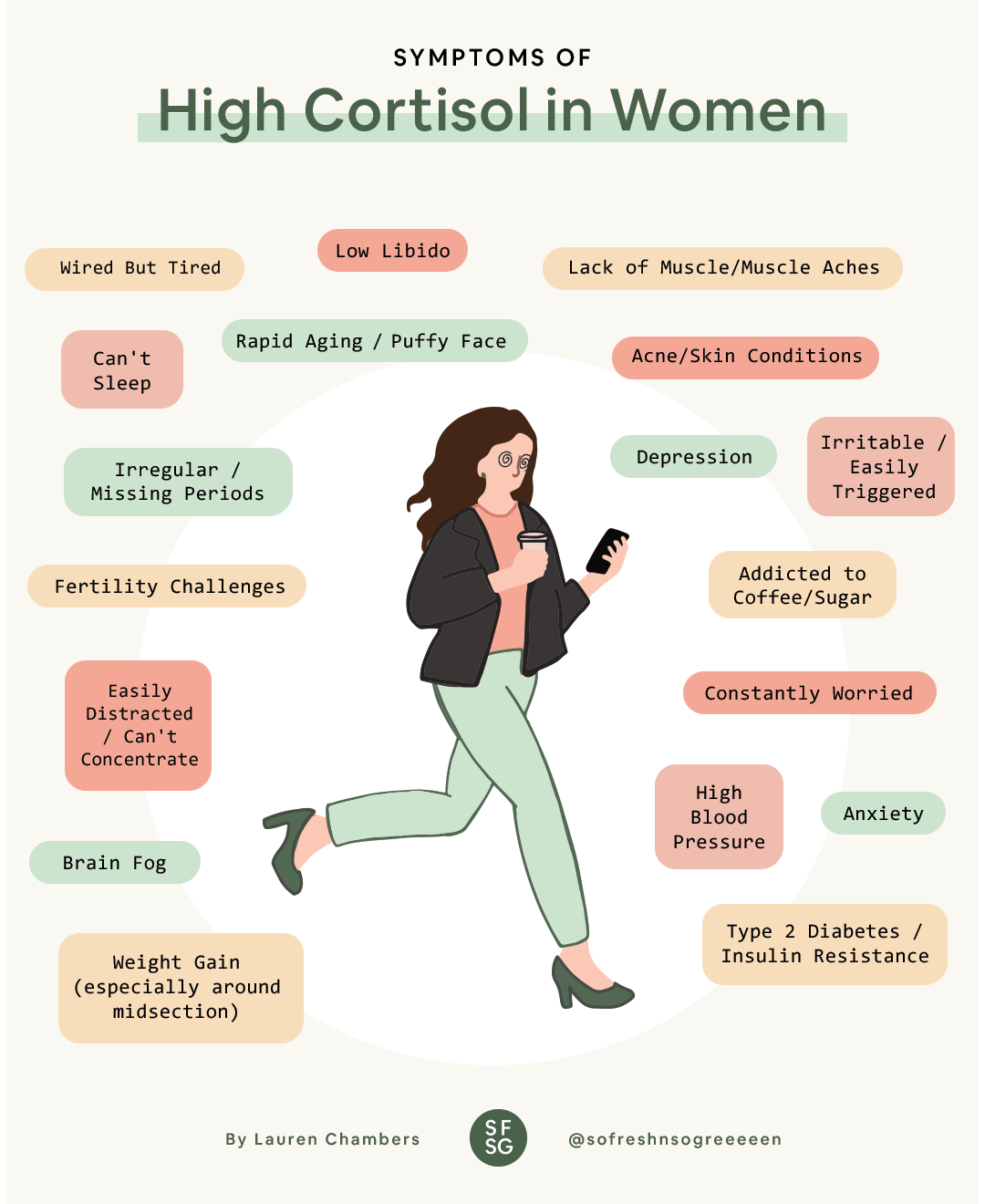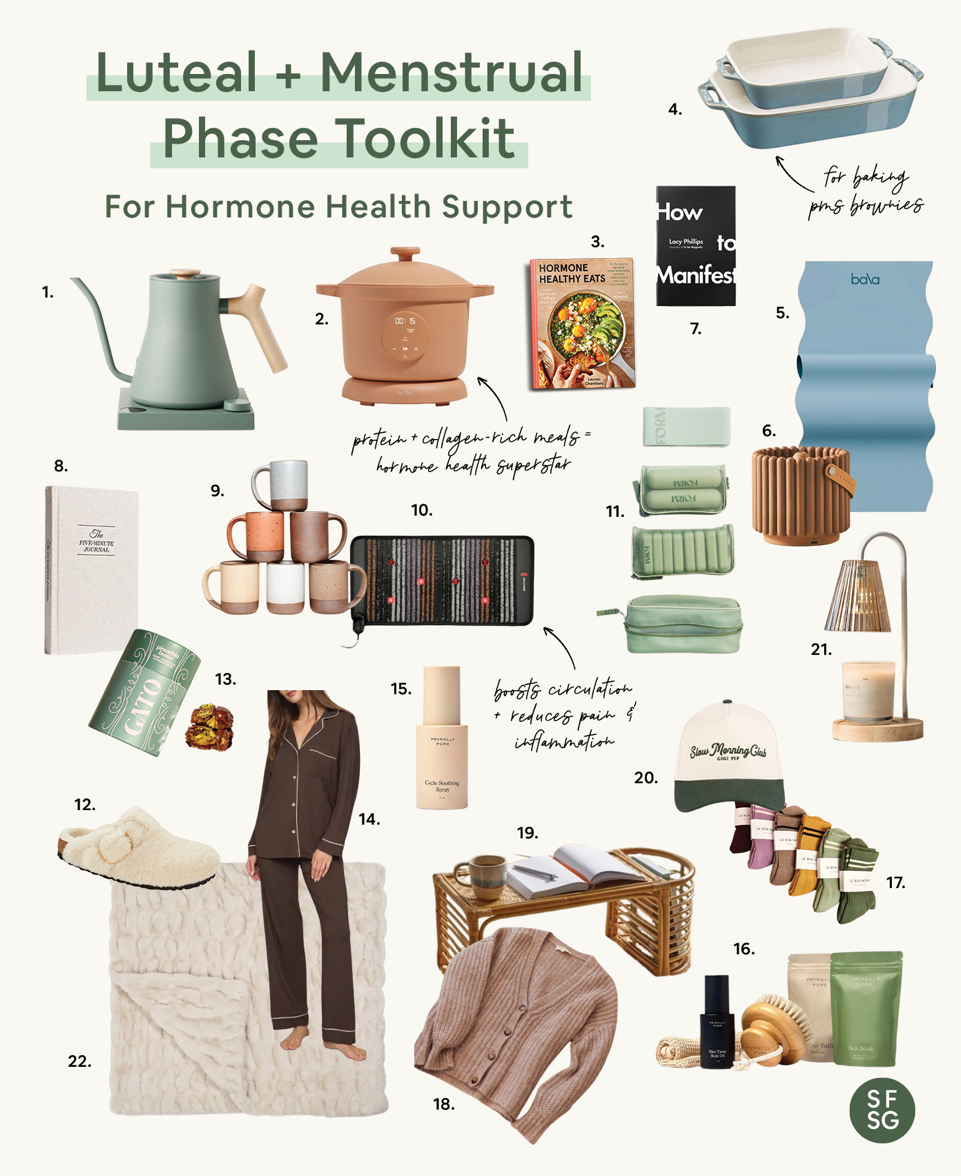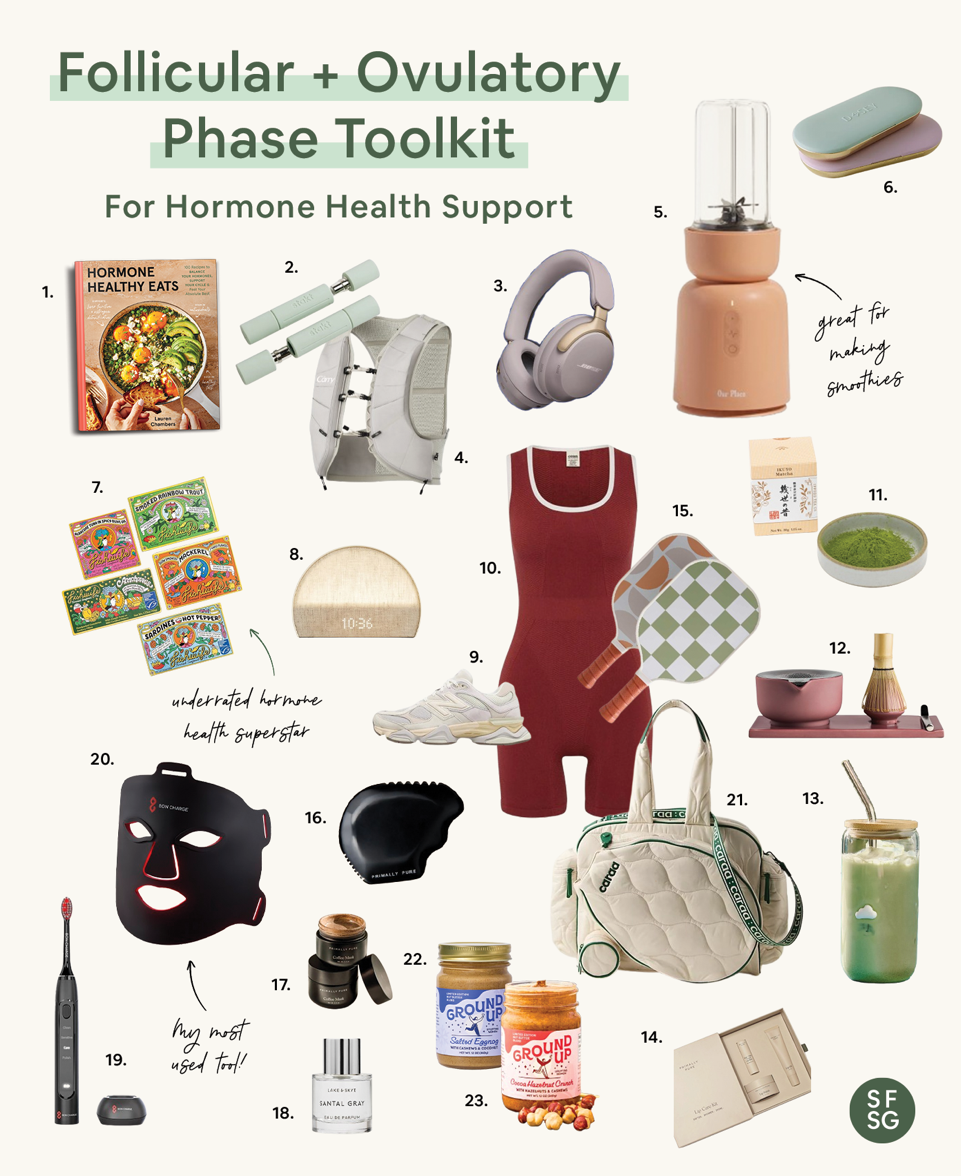recipes
lifestyle
wellness
motherhood
mindset
About
E-Books
Blog
Freebies
partnerships
hi, i'm lauren!
hey there!
I’m on a hot mission to help you balance your hormones & live your best life.
categories
Home
Quiz
Get In Touch
The Course
search:
Cookbook
Recipe key
GF
VG
P
Vegan
Gluten Free
Paleo
DF
Dairy-Free
download now
Join Hormone Healthy Eats!
Become a SFNSG insider to get my monthly Substack, Hormone Healthy Eats! Packed with the latest hormone-healthy recipes
+ tips.
jump to recipe >
Cortisol, our primary stress hormone, seems to be a buzzword these days, and it makes sense given everything going on in our modern world and the mental, physical and emotional challenges so many of us (especially women) face on a daily basis.
While chronic stress exposure can be detrimental to our hormones and overall health, it’s a lot more complex than that, and we actually NEED our stress hormones, not just for survival, but for so many other important biological functions.
Thus the goal isn’t to have low cortisol levels or rid our body of stress hormones, rather to address any root causes of high cortisol in order to promote a healthy cortisol balance and rhythm in the body, which is essential to looking and feeling our best.
This post covers all of the symptoms of high cortisol levels in females, to help you determine if you potentially have this hormone imbalance, the first part of any hormone healing journey (if so, you can check out this post on how to reduce high cortisol levels naturally).
Wondering if you have high cortisol levels or another hormonal imbalance? Take this free quiz to investigate.
WHAT IS CORTISOL?
Cortisol is a stress hormone (along with adrenaline) produced by our adrenal glands, which sit atop our kidneys. Our adrenal glands communicate directly with our brains, specifically the hypothalamus region and the pituitary gland, which altogether is known as the Hypothalamic- Pituitary- Adrenal Axis or HPA axis for short. This axis is responsible for adjusting the balance of hormones in response to stress.
When cortisol is released by the adrenal glands in response to a perceived stressor recognized by the brain, it works to:
-
+ Mobilize energy from storage sites (such as muscles and tissues) in the body for immediate use
-
+ Break down molecules to release energy
-
+ Reduce inflammation and allergies
-
+ Prevent the loss of sodium in the urine to help maintain blood volume and blood pressure
-
+ Help maintain mood and emotional stability
WHAT IS HIGH CORTISOL OR A CORTISOL IMBALANCE?
As you can see, cortisol plays a very important role in our bodies, especially when danger is imminent. But, while highly effective at keeping our species alive, the primary problem with our stress response system is that it’s still stuck in the primal ages. Meaning that it can’t differentiate between a life or death situation vs. every day modern stressors we’re exposed to such as work emails, sitting in traffic, tensions with family or reading the news. No matter the details, any perceived stressor triggers the exact same chemical response.
Thus repeat exposure to “stressors” often leads to an overproduction of cortisol, a hormone imbalance known as high cortisol. This can present with either consistently high cortisol levels or a dysregulated rhythm in cortisol where it is low in the morning (when you need it to be high to sustain energy levels throughout the day) and high at night (when you need it to be lower in order to get a restful night’s sleep).
HOW STRESS IMPACTS OUR HORMONES
Before we jump into specific symptoms of high cortisol levels in women, it’s important to understand some of the ways chronic stress affects our hormones, which THEN lead to the symptoms we experience as a result.
+ Lowers Progesterone
All of our steroid hormones, including progesterone, estrogen, testosterone, DHEA and cortisol are made from a precursor hormone called pregnenolone. Chronic cortisol output requires more of the precursor pregnenolone, and it “steals” this hormone, primarily from progesterone, in a process known as the “pregnenolone steal.” Low progesterone is a common hormonal imbalance associated with symptoms ranging from pms to fertility challenges.
+ Increases Estrogen Levels
When cortisol lowers progesterone, both by stealing the precursor pregnenolone and by decreasing the effectiveness at which progesterone gets into the cells, it can lead to estrogen dominance (progesterone is needed to keep estrogen levels in check). This is yet another common hormonal imbalance that often includes symptoms ranging from heavy and painful periods to cyclical acne.
+ Lowers Testosterone
Chronic stress exposure activates the HPA axis, thereby naturally inhibiting the activity of the hypothalamic-pituitary-gonadal axis (HPG axis), which can block androgen receptors and lead to a decrease in testosterone production which is necessary for a healthy menstrual cycle, fertility, libido and mood.
+ Delays or Prevents Ovulation
Chronic cortisol production communicates to your ovaries to naturally decrease estrogen and progesterone production and marks ovulation, a process that requires a lot of nutrients and energy, as low priority, in order to divert the resources to a much higher priority potential life or death situation (which we know it often actually isn’t). Ovulation is THE cornerstone of a healthy menstrual cycle (you cannot have a true period without it) and it’s also needed for progesterone production, not to mention a necessary part of conception.
+ Lowers Thyroid Function
When cortisol levels are chronically elevated, it signals to the thyroid gland to stop producing as much thyroid hormone. It also restricts the conversion of inactive thyroid hormone T4 to active thyroid hormone T3, which is the form of thyroid that cells can actually use, leading to low thyroid function and symptoms including weight gain, hair loss, constipation, and heavy or missing periods.
Along with these hormonal imbalances, chronic cortisol output can also lead to an increase in inflammation and blood sugar instability, decrease in muscle mass, impaired digestion and depletion of nutrients and place a burden our liver, all of which can contribute to the symptoms mentioned below.
SYMPTOMS OF HIGH CORTISOL LEVELS IN FEMALES
Symptoms of chronically elevated cortisol levels can present in females in a myriad of ways, and are also commonly linked to other hormone imbalances such as low thyroid, low progesterone and excess estrogen (see above). Here are some of the most common symptoms I see with female clients in my practice:
+ Wired But Tired
+ Can’t Sleep
+ Irregular/Missing Periods
+ Fertility Challenges
+ Brain Fog
+ Easily Distracted/Can’t Concentrate
+ Addicted to Coffee/Sugar
+ Anxiety
+ Constantly Worried
+ Depression
+ High Blood Pressure
+ Type 2 Diabetes/Insulin Resistance
+ Weight Gain/”Cortisol Belly”
+ Rapid Aging/Puffy Face
+ Acne/Skin Conditions
+ Irritable/Easily Triggered
+ Lack of Muscle/Muscle Aches
+ Low Libido
+ Digestive Issues
+ Sluggish Liver/Trouble Detoxing
ROOT CAUSES + TRIGGERS OF HIGH CORTISOL LEVELS IN FEMALES
Obviously, exposure to chronic stress is the underlying root cause of high cortisol levels, but that can be pretty broad. To narrow it down, I teach my clients about the four distinct types of stress that have a direct impact on our adrenal glands and cortisol levels, including:
+ Physical Stressors
This includes illness, injury, extreme dieting, eating disorders, toxin exposure, extreme temperatures, poor sleep quality, overexercising, food allergies or a diet filled with processed and inflammatory foods, etc.
+ Mental Stressors
This encompasses experiences that contribute to our mental burden or load such as isolation, information overload, uncertainty, lack of control, loss, job demands, financial debt, etc.
+ Emotional Stressors
Stressful emotions we experience such as grief, worry, frustration, anger, anxiety, rage, etc.
+ Perceived Stress
Perceived stress is the extent in which people feel the demands of stress and their ability to cope (meaning one person may be able to cope with certain stressors better than another person based on how they perceive the stressor).
While we may not have control over certain stressful situations and the emotional fallout (a loved one passing, losing a job, etc.) most of us have control over the majority of our physical stressors, thus focusing on these first can be an effective way to naturally balance cortisol levels.
HOW TO TELL IF YOU HAVE A CORTISOL IMBALANCE
First and foremost, if you consistently experience any of the above stressors and the linked symptoms as a result, chances are you are dealing with elevated cortisol levels or a cortisol imbalance. Because hormones are intricately linked, there may be multiple imbalances at play, and I always encourage testing as getting an accurate gage of where your hormones are at.
A few lower cost, yet comprehensive tests to get you started include a four-point saliva panel stress and sex hormone test or a DUTCH urine test, which you can typically order through a functional medicine practitioner that specializes in hormones. I also offer a free hormonal imbalance quiz you can take to investigate further (please note this is not a substitute for an official diagnosis).
HOW TO LOWER HIGH CORTISOL LEVELS NATURALLY
While it’s not realistic to “get rid of” stress, the good news is most of us have plenty of tools at our disposal to both reduce exposure to chronic stressors and boost our stress resilience, thereby protecting our hormones and adrenal glands and mitigating some of the negative effects. For a full guide, read this post (which covers the tips below in detail).
+ Eat nutrient-dense meals regularly
+ Opt for low impact movement
+ Up your mineral intake
+ Incorporate herbs + adaptogens
+ Expose yourself to am sunlight
+ Have breakfast before coffee
+ Limit blue light exposure
+ Set firm boundaries
+ Activate your vagus nerve
+ Limit news/social media consumption
+ Prioritize play + pleasure
MORE CORTISOL REDUCING RESOURCES
+ TIPS TO LOWER CORTISOL NATURALLY
+ WATERMELON MINT CORTISOL MOCKTAIL
+ HOW TO SUPPORT YOUR HORMONES DURING STRESSFUL TIMES
This post contains affiliate links. We may receive a small commission for purchases made through these links. Thank you for your support!

If you loved that...

01.

02.

03.

04.

05.
hey!
Keep Browsing
Site
Keep Browsing
Site
the
about
e-books
blog
downloads
quiz
Welcome friend, I'm lauren.
I’m honored to support you on your journey to optimal hormone health + happiness. Thanks for being here babe.


